As ports become more complex and interconnected, the need for intelligent systems to manage traffic flow, resource allocation, and environmental impact has become critical. This report highlights the key role digital technologies are playing in transforming port and maritime logistics, outlining what the future vision of RoPax traffic operations should look like.
From the use of AI-based systems to automate vehicle and cargo handling, automated check-in, and digital allocation of boarding zones, real-time traffic management, and predictive analytics to streamline port operations by minimizing human error and reducing bottlenecks, to the integration of AI with historical and real-time data to better anticipate ship arrivals, plan berth assignments, and optimize terminal capacity. All of this significantly improves port performance, user experience, and reduces waiting times.
In the future, the use of augmented reality (AR) for port staff, machine learning algorithms, gamification, the use of autonomous equipment, and flexible route systems are some of the advanced technologies expected to play an important role. These innovations will not only boost operational efficiency but also ensure that ports remain competitive in the global supply chain while adhering to sustainability goals.
“Although this vision has not yet been fully implemented, it represents a future perspective for ports with RoPax operations, their customers, and technological development.”
The main inputs and contributions are:
- The report is based on the success story of the Port of Tallinn, which handles over 10 million passengers, 2 million vehicles, and 5,500 ferry and cruise ship calls annually. Its digital transformation strategy aims to greatly scale up the automation of RoPax traffic flows and develop more advanced data orchestration.
- Some of the solutions they have deployed include a pre-gate system for free-flow data capture (vehicle dimensions, license plate matching with reservations, and in the future, the possible identification of dangerous goods, passenger counting, etc.). They also have personalized signage based on reservation data to separate traffic by cars and trucks. An automatic, staff-free check-in system for scanning vehicle license plates (for specific cases) with a processing time of 2 seconds per vehicle, a digitized traffic control system with no human intervention, and finally, the integration of boarding data with external IT systems such as police, border control, customs, shipping companies, etc., involving a total of 25 stakeholders.
- The future vision of this type of port traffic involves data capture at every point in the process to optimize and improve operations through predictive analysis, offering advantages to passengers via personalized services and offers (customer-centered approach) and a seamless customer experience where all unnecessary actions are eliminated. Additionally, sustainability and safety are reinforced through smart technologies.
- In terms of operational efficiency, the following disruptive solutions stand out: (1) AR glasses to monitor relevant operational information in real-time; (2) digitally-assisted inland terminals to manage just-in-time traffic and relieve port and city center congestion; (3) computer vision to identify bottlenecks, illegal parking, etc.; (4) the use of light beams to flexibly display changing routes at the terminal; and (5) traffic control in the port-city integration.
- Regarding customer experience, some key points are: (1) a gamification program for truck drivers to incentivize adherence to operational procedures; (2) personalized offers as passengers move through the terminal on foot or by car; (3) gamification during waiting periods, using screens and apps to engage passengers while they wait; (4) the use of small delivery robots to bring freshly made food, drinks, or small duty-free purchases; (5) providing passengers with a pocket AI assistant to ask questions in natural language during their journey; and (6) ensuring that passengers and drivers are well-informed and feel secure during the port process, offering personalized wait messages, predictive wait time data, etc.
- In terms of data management, we find: (1) developing a smart port data ecosystem with holistic, end-to-end analysis; (2) operational AI/large language model (LLM) solutions for conversational advice on real-time operations management; (3) direct logistical integration with shipping companies for seamless connectivity; and (4) remote identity verification.
“This is the vision of the Smart Port, where data is captured at every point of contact, feeding predictive analysis to drive efficiency and performance. The focus is on a seamless customer experience, eliminating unnecessary actions to create a frictionless journey.”




Leave a Reply